Switching Characteristics and High-Temperature Dielectric Relaxation Behaviours of Pb(Zn1/3Nb2/3)0.91Ti0.09O3 Single Crystal
Abstract
:1. Introduction
2. Experimental Section
3. Results and Discussion
4. Conclusions
Acknowledgments
Author Contributions
Conflicts of Interest
References
- Meijer, G.I. Materials science—Who wins the nonvolatile memory race? Science 2008, 319, 1625–1626. [Google Scholar] [CrossRef] [PubMed]
- Waser, R.; Aono, M. Nanoionics-based resistive switching memories. Nat. Mater. 2007, 6, 833–840. [Google Scholar] [CrossRef] [PubMed]
- Panda, D.; Huang, C.Y.; Tseng, T.Y. Resistive switching characteristics of nickel silicide layer embedded HfO2 film. Appl. Phys. Lett. 2012, 100, 112901. [Google Scholar] [CrossRef]
- Ghenzi, N.; Rozenberg, M.J.; Llopis, R.; Levy, P.; Hueso, L.E.; Stoliar, P. Tuning the resistive switching properties of TiO2-x films. Appl. Phys. Lett. 2015, 106, 123509. [Google Scholar] [CrossRef]
- Santhanakrishna, A.K.; Takshi, A. Photoelectric Memory Effect in an Organic Bulk Heterojunction Device. J. Phys. Chem. C 2015, 119, 17253–17259. [Google Scholar] [CrossRef]
- Li, J.C.; Hou, X.Y.; Cao, Q. Effect of Cu doping on the resistive switching of NiO thin films. J. Appl. Phys. 2014, 115, 164507. [Google Scholar] [CrossRef]
- Salomone, L.S.; Kasulin, A.; Carbonetto, S.H.; Garcia-Inza, M.A.; Redin, E.G.; Berbeglia, F.; Lipovetzky, J.; Faigón, A.; Campabadal, F. Radiation and bias switch-induced charge dynamics in Al2O3-based metal-oxide-semiconductor structures. J. Appl. Phys. 2014, 116, 174506. [Google Scholar] [CrossRef]
- Chen, Y.C.; Chung, Y.L.; Chen, B.T.; Chen, W.C.; Chen, J.S. Revelation on the Interrelated Mechanism of Polarity-Dependent and Multilevel Resistive Switching in TaOx-Based Memory Devices. J. Phys. Chem. C 2013, 117, 5758–5764. [Google Scholar] [CrossRef]
- Zhang, Y.; Deng, N.; Wu, H.; Yu, Z.; Zhang, J.; Qian, H. Metallic to hopping conduction transition in Ta2O5-x/TaOy resistive switching device. Appl. Phys. Lett. 2014, 105, 063508. [Google Scholar] [CrossRef]
- Huang, Z.C.; Chen, Q.; Zhai, Y.; Wang, J.L.; Xu, Y.B. Oxygen vacancy induced magnetization switching in Fe3O4 epitaxial ultrathin films on GaAs(100). Appl. Phys. Lett. 2015, 106, 182401. [Google Scholar] [CrossRef]
- Sim, H.J.; Choi, D.; Lee, D.; Seo, S.; Lee, M.-J.; Yoo, I.-K.; Hwang, H. Resistance-switching Characteristics of polycrystalline Nb2O5 for nonvolatile memory application. IEEE Electron. Dev. Lett. 2005, 26, 292–294. [Google Scholar]
- Kubicek, M.; Schmitt, R.; Messerschmitt, F.; Jennifer, L.M.R. Uncovering Two Competing Switching Mechanisms for Epitaxial and Ultrathin Strontium Titanate-Based Resistive Switching Bits. ACS Nano 2015, 9, 10737–10748. [Google Scholar] [CrossRef] [PubMed]
- Park, J.H.; Kwon, D.H.; Park, H.G.; Jung, C.U.; Kim, M. Role of oxygen vacancies in resistive switching in Pt/Nb-doped SrTiO3. Appl. Phys. Lett. 2014, 105, 183103. [Google Scholar] [CrossRef]
- Guo, Z.L.; Sa, B.S.; Zhou, J.; Sun, Z.M. Role of oxygen vacancies in the resistive switching of SrZrO3 for resistance random access memory. J. Alloy. Compd. 2013, 580, 148–151. [Google Scholar] [CrossRef]
- Seong, T.G.; Choi, K.B.; Seo, I.T.; Oh, J.H.; Moon, J.W.; Hong, K.; Nahm, S. Resistive switching properties of amorphous Pr0.7Ca0.3MnO3 films grown on indium tin oxide/glass substrate using pulsed laser deposition method. Appl. Phys. Lett. 2012, 100, 212111. [Google Scholar] [CrossRef]
- Sawa, A. Resistive switching in transition metal oxides. Mater. Today 2008, 11, 28–36. [Google Scholar] [CrossRef]
- Chen, X.; Tang, X.; Chen, X.-Z.; Chen, Y.-L.; Guo, X.; Ge, H.-X.; Shen, Q.-D. Nonvolatile data storage using mechanical force-induced polarization switching in ferroelectric polymer. Appl. Phys. Lett. 2015, 106, 042903. [Google Scholar] [CrossRef]
- Xie, Z.K.; Yue, Z.; Ruehl, G.; Peng, B.; Zhang, J.; Yu, Q.; Zhang, X.; Li, L. Bi(Ni1/2Zr1/2)O3-PbTiO3 relaxor-ferroelectric films for piezoelectric energy harvesting and electrostatic storage. Appl. Phys. Lett. 2014, 104, 243902. [Google Scholar] [CrossRef]
- Guo, E.J.; Herklotz, A.; Roth, R.; Christl, M.; Das, S.; Widdra, W.; Dörr, K. Tuning the switching time of BiFeO3 capacitors by electrodes’ conductivity. Appl. Phys. Lett. 2013, 103, 022905. [Google Scholar] [CrossRef]
- Yan, F.; Xing, G.Z.; Li, L. Low temperature dependent ferroelectric resistive switching in epitaxial BiFeO3 films. Appl. Phys. Lett. 2014, 104, 132904. [Google Scholar] [CrossRef]
- Zhang, L.X.; Chen, J.; Cao, J.L.; He, D.Y.; Xing, X.R. Large resistive switching and switchable photovoltaic response in ferroelectric doped BiFeO3-based thin films by chemical solution deposition. J. Mater. Chem. C 2015, 3, 4706–4712. [Google Scholar] [CrossRef]
- Zhao, B.Y.; Chen, Z.; Meng, J.; Lu, H.; Zhang, D.W.; Jiang, A. Ferroelectric polarization and defect-dipole switching in an epitaxial (111) BiFeO3 thin film. J. Appl. Phys. 2015, 117, 204103. [Google Scholar] [CrossRef]
- Zhao, Y.J.; Yin, Z.G.; Zhang, X.W.; Fu, Z.; Wu, J.L. Formation and local conduction of nanopits in BiFeO3 epitaxial films. J. Mater. Chem. C 2015, 3, 11250–11256. [Google Scholar] [CrossRef]
- Shuai, Y.; Ou, X.; Wu, C.; Zhang, W.; Zhou, S.; Bürger, D.; Reuther, H.; Slesazeck, S.; Mikolajick, T.; Helm, M.; et al. Substrate effect on the resistive switching in BiFeO3 thin films. J. Appl. Phys. 2012, 111, 07D906–07D908. [Google Scholar] [CrossRef]
- Park, S.E.; Shrout, T.R. Characteristics of relaxor-based piezoelectric single crystals for ultrasonic transducers. IEEE Trans. Ultrason. Ferroelectr. Freq. Control 1997, 44, 1140–1147. [Google Scholar] [CrossRef]
- Bertram, R.; Reck, G.; Uecker, R. Growth and correlation between composition and structure of (1 − x)Pb(Zn1/3Nb2/3)O3–xPbTiO3 crystals near the morphotropic phase boundary. J. Cryst. Growth 2003, 253, 212–220. [Google Scholar] [CrossRef]
- Fang, B.J.; Xu, H.Q.; He, T.H.; Luo, H.S.; Yin, Z.W. Growth mechanism and electrical properties of [Pb(Zn1/3Nb2/3)0.91Ti0.09]O3 single crystals by a modified Bridgman method. J. Crystal. Growth 2002, 244, 318–326. [Google Scholar] [CrossRef]
- Zhang, H. Polarization rotation and field induced phase transition in PZN-4.5%PT single crystal. J. Appl. Phys. 2013, 114, 084109. [Google Scholar] [CrossRef]
- Zhang, H. Polarization rotation and phase transition in [100]-oriented PZN-PT single crystals determined by the electro-crystalline anisotropy. J. Appl. Phys. 2013, 114, 184102. [Google Scholar] [CrossRef]
- Bao, P.; Yan, F.; Dai, Y.; Zhu, J.; Wang, Y.; Luo, H. Dielectric relaxation in 91%Pb(Zn1/3Nb2/3)O3–9%PbTiO3 single crystal at low temperature. Appl. Phys. Lett. 2004, 84, 5317–5319. [Google Scholar] [CrossRef]
- Pilch, M.; Molak, A. Resistivity switching induced in ferroelectric phase of PbTiO3 studied by XPS and electric conductivity tests. J. Alloy. Compd. 2014, 586, 488–498. [Google Scholar] [CrossRef]
- Tang, X.G.; Jiang, L.L.; Kuang, S.J.; Ding, A.L.; Chan, H.L.W. Dielectric and pyroelectric properties of compositionally graded Pb(Zr1-xTix)O3 thin films prepared by sol-gel process. Chin. J. Chem. Phys. 2007, 20, 665–669. [Google Scholar] [CrossRef]
- Tang, X.G.; Chan, H.L.W.; Ding, A.L. Electrical properties of compositionally graded lead calcium titanate thin films. Solid State Commun. 2003, 127, 625–628. [Google Scholar] [CrossRef]
- Wouters, D.J.; Waser, R.; Wuttig, M. Phase-Change and Redox-Based Resistive Switching Memories. Proc. IEEE 2015, 103, 1274–1288. [Google Scholar] [CrossRef]
- Qiu, J.; Shih, A.; Zhou, W.D.; Mi, Z.T.; Shih, I. Effects of metal contacts and dopants on the performance of ZnO-based memristive devices. J. Appl. Phys. 2011, 110, 014513. [Google Scholar] [CrossRef]
- Fujii, T.; Kawasaki, M.; Sawa, A.; Akoh, H.; Kawazoe, Y.; Tokura, Y. Hysteretic Current-Voltage Characteristics and Resistance Switching at an Epitaxial Oxide Schottky Junction SrRuO3/SrTi0.99Nb0.01O3. Appl. Phys. Lett. 2005, 86, 012107. [Google Scholar] [CrossRef]
- Sawa, A.; Fujii, T.; Kawasaki, M.; Tokura, Y. Hysteretic Current-Voltage Characteristics and Resistance Switching at a Rectifying Ti/Pr0.7Ca0.3MnO3 Interface. Appl. Phys. Lett. 2004, 85, 4073–4075. [Google Scholar] [CrossRef]
- Lee, M.H.; Kim, K.M.; Kim, G.H.; Seok, J.Y.; Song, S.J.; Yoon, J.H.; Hwang, C.S. Study on the Electrical Conduction Mechanism of Bipolar Resistive Switching TiO2 Thin Films Using Impedance Spectroscopy. Appl. Phys. Lett. 2010, 96, 152909. [Google Scholar] [CrossRef]
- Shang, D.S.; Wang, Q.; Chen, L.D.; Dong, R.; Li, X.M.; Zhang, W.Q. Effect of Carrier Trapping on the Hysteretic Current–Voltage Characteristics in Ag/La0.7Ca0.3MnO3/Pt Heterostructures. Phys. Rev. B 2006, 73, 245427. [Google Scholar] [CrossRef]
- Kim, D.C.; Seo, S.; Ahn, S.E.; Suh, D.-S.; Lee, M.J.; Park, B.-H.; Yoo, I.K.; Baek, I.G.; Kim, H.-J.; Yim, E.K.; et al. Electrical Observations of Filamentary Conductions for the Resistive Memory Switching in NiO Films. Appl. Phys. Lett. 2006, 88, 202102. [Google Scholar] [CrossRef]
- Rohde, C.; Choi, B.J.; Jeong, D.S.; Choi, S.; Zhao, J.-S.; Hwang, C.S. Identification of a Determining Parameter for Resistive Switching of TiO2 Thin Films. Appl. Phys. Lett. 2005, 86, 262907. [Google Scholar] [CrossRef]
- Fujimoto, M.; Koyama, H.; Konagai, M.; Hosoi, Y.; Ishihara, K.; Ohnishi, S.; Awaya, N. TiO2 Anatase Nanolayer on TiN Thin Film Exhibiting High- Speed Bipolar Resistive Switching. Appl. Phys. Lett. 2006, 89, 223509. [Google Scholar] [CrossRef]
- Jeon, S.H.; Park, B.H.; Lee, J.; Lee, B.; Han, S. First-principles Modeling of Resistance Switching in Perovskite Oxide Material. Appl. Phys. Lett. 2006, 89, 042904. [Google Scholar] [CrossRef]
- Maksymovych, P.; Jesse, S.; Yu, P.; Ramesh, R.; Baddorf, A.P.; Kalinin, S.V. Polarization Control of Electron Tunneling into Ferroelectric Surfaces. Science 2009, 324, 1421–1425. [Google Scholar] [CrossRef] [PubMed]
- Garcia, V.; Fusil, S.; Bouzehouane, K.; Enouz-Vedrenne, S.; Mathur, N.D.; Barthelemy, A.; Bibes, M. Giant tunnel electroresistance for non-destructive readout of ferroelectric states. Nature 2009, 460, 81–84. [Google Scholar] [CrossRef] [PubMed]
- Wang, C.; Jin, K.J.; Xu, Z.T.; Wang, L.; Ge, C.; Lu, H.B.; Guo, H.Z.; He, M.; Yang, G.Z. Switchable diode effect and ferroelectric resistive switching in epitaxial BiFeO3 thin films. Appl. Phys. Lett. 2011, 98, 192901. [Google Scholar] [CrossRef]
- Mojarad, S.A.; Goss, J.P.; Kwa, K.S.K.; Zhou, Z.Y.; Al-Hamadany, R.A.S.; Appleby, D.J.R.; Ponon, N.K.; O’Neill, A. Leakage current asymmetry and resistive switching behavior of SrTiO3. Appl. Phys. Lett. 2012, 101, 173507. [Google Scholar] [CrossRef]
- Hosono, Y.; Harada, K.; Kobayashi, T.; Itsumi, K.; Izumi, M.; Yamashita, Y.; Ichinose, N. Temperature dependence of dielectric and piezoelectric properties of Pb(Zn1/3Nb2/3)O3-PbTiO3 piezoelectric single crystals. Jpn. J. Appl. Phys. 2002, 41, 7084–7088. [Google Scholar] [CrossRef]
- Zhang, T.F.; Tang, X.G.; Huang, X.X.; Liu, Q.X.; Jiang, Y.P.; Zhou, Q.F. High-Temperature Dielectric Relaxation Behaviors of Relaxer-Like PbZrO3-SrTiO3 Ceramics for Energy-Storage Applications. Energy Technol. 2016, 4, 633–640. [Google Scholar] [CrossRef]
- Zhang, J.J.; Zhai, J.W.; Zhang, Y.W. Microwave and infrared dielectric response in BaTiO3 based relaxor ferroelectrics. Phys. Status Solidi A 2011, 208, 2853–2860. [Google Scholar] [CrossRef]
- Chou, X.J.; Zhai, J.W.; Yao, X. Dielectric tunable properties of low dielectric constant Ba0.5Sr0.5TiO3-Mg2TiO4 microwave composite ceramics. Appl. Phys. Lett. 2007, 91, 122903–122908. [Google Scholar] [CrossRef]
- Feng, Z.Y.; Zhao, X.Y.; Luo, H.S. Composition and orientation dependence of phase configuration and dielectric constant tunability in poled Pb(Mg1/3Nb2/3)O3-PbTiO3 single crystal. J. Phys. Condens. Matter 2004, 16, 6771–6778. [Google Scholar] [CrossRef]
- Tang, X.G.; Chew, K.-H.; Chan, H.L.W. Diffuse phase transition and dielectric tunability of Ba(ZryTi1-y)O3 relaxor ferroelectric ceramics. Acta Mater. 2004, 52, 5177–5183. [Google Scholar] [CrossRef]
- Pati, B.; Choudhary, R.N.P.; Das, P.R.; Parida, B.N.; Padhee, R. Pyroelectric and dielectric properties of lead-free ferroelectric Ba3Nb2O8 ceramic. J. Alloy. Compd. 2014, 592, 6–11. [Google Scholar] [CrossRef]
- Whatmore, W.R.; Patel, A.; Shorrock, N.M.; Ainger, F.W. Ferroelectric materials for thermal ir sensors state-of-the-art and perspectives. Ferroelectrics 1990, 104, 269–283. [Google Scholar] [CrossRef]
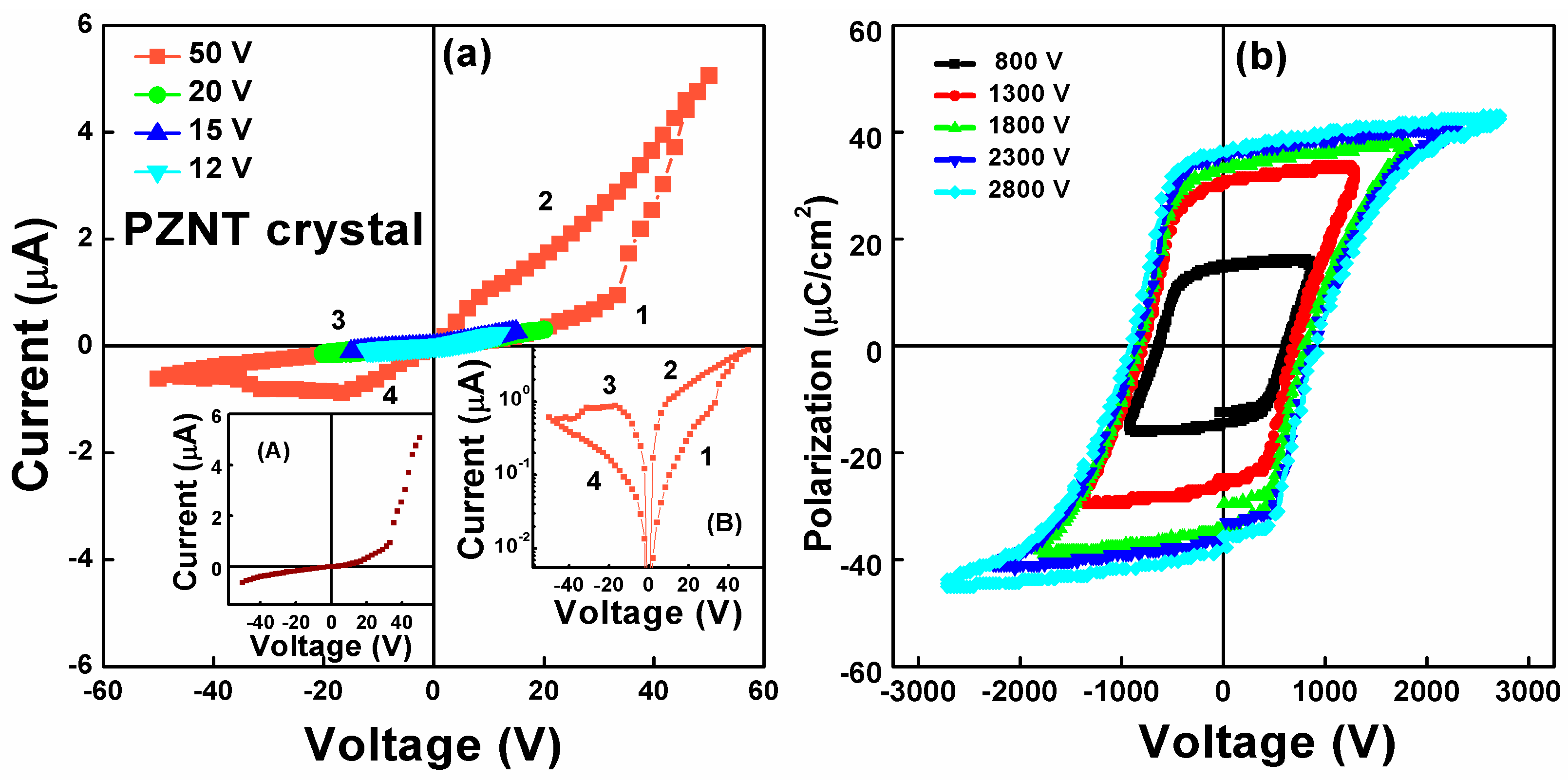
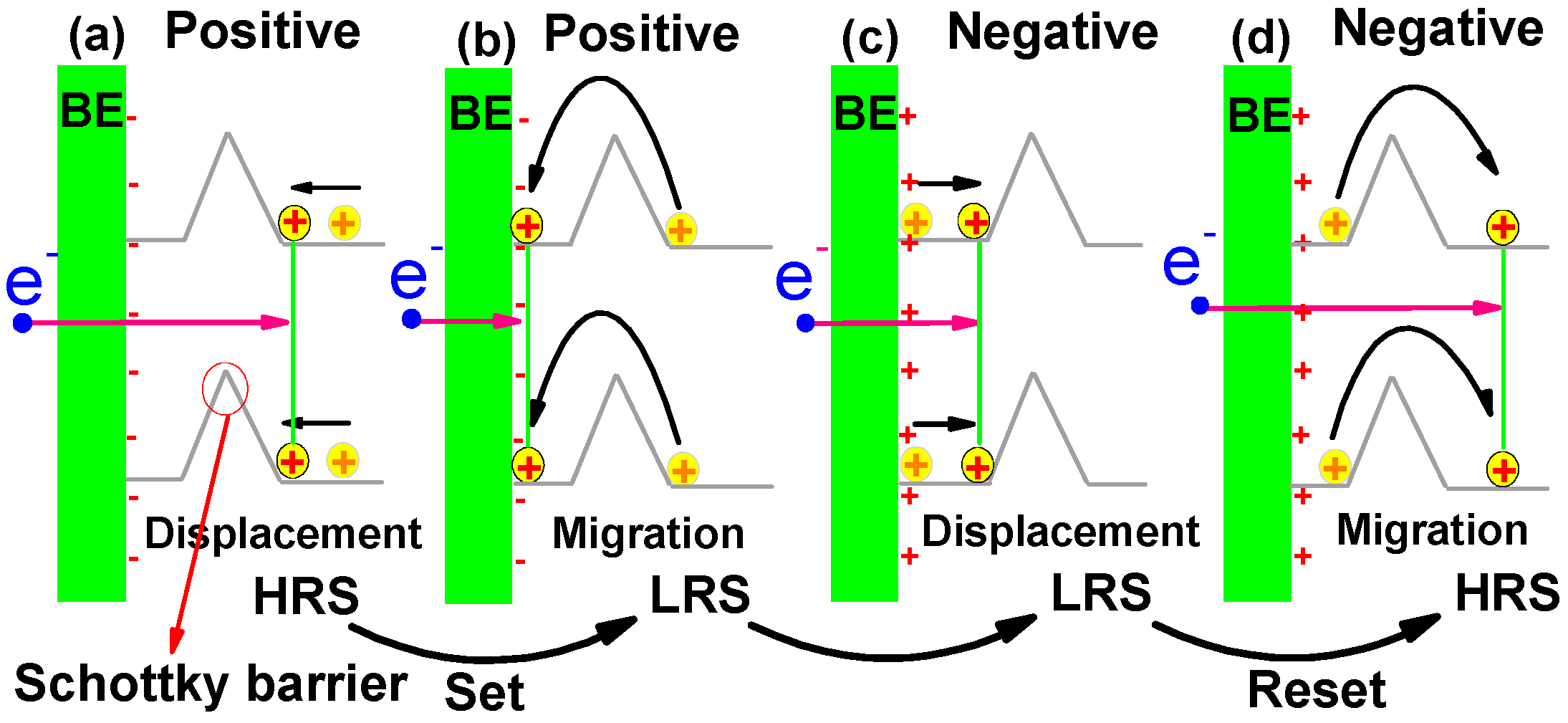
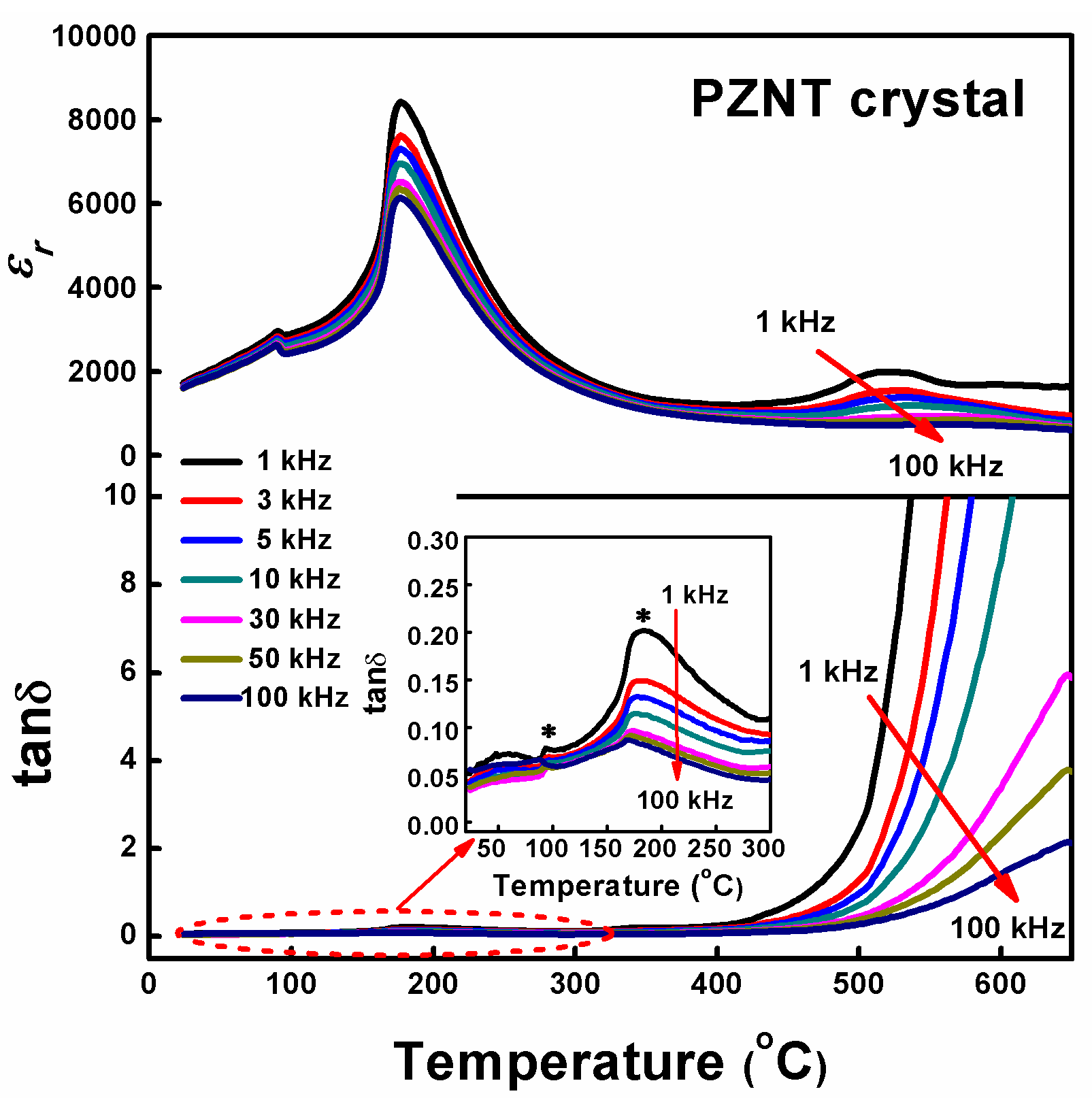
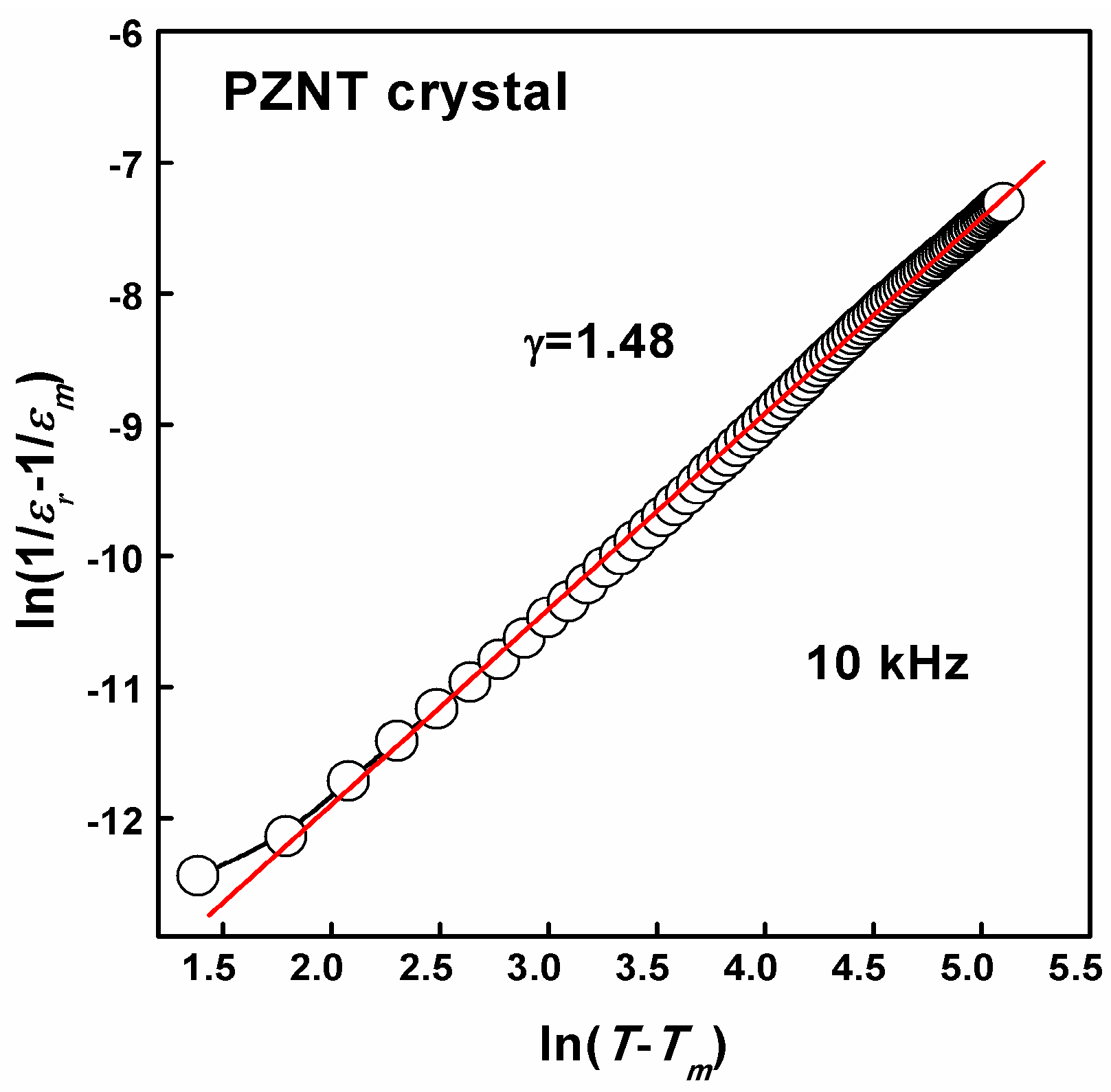
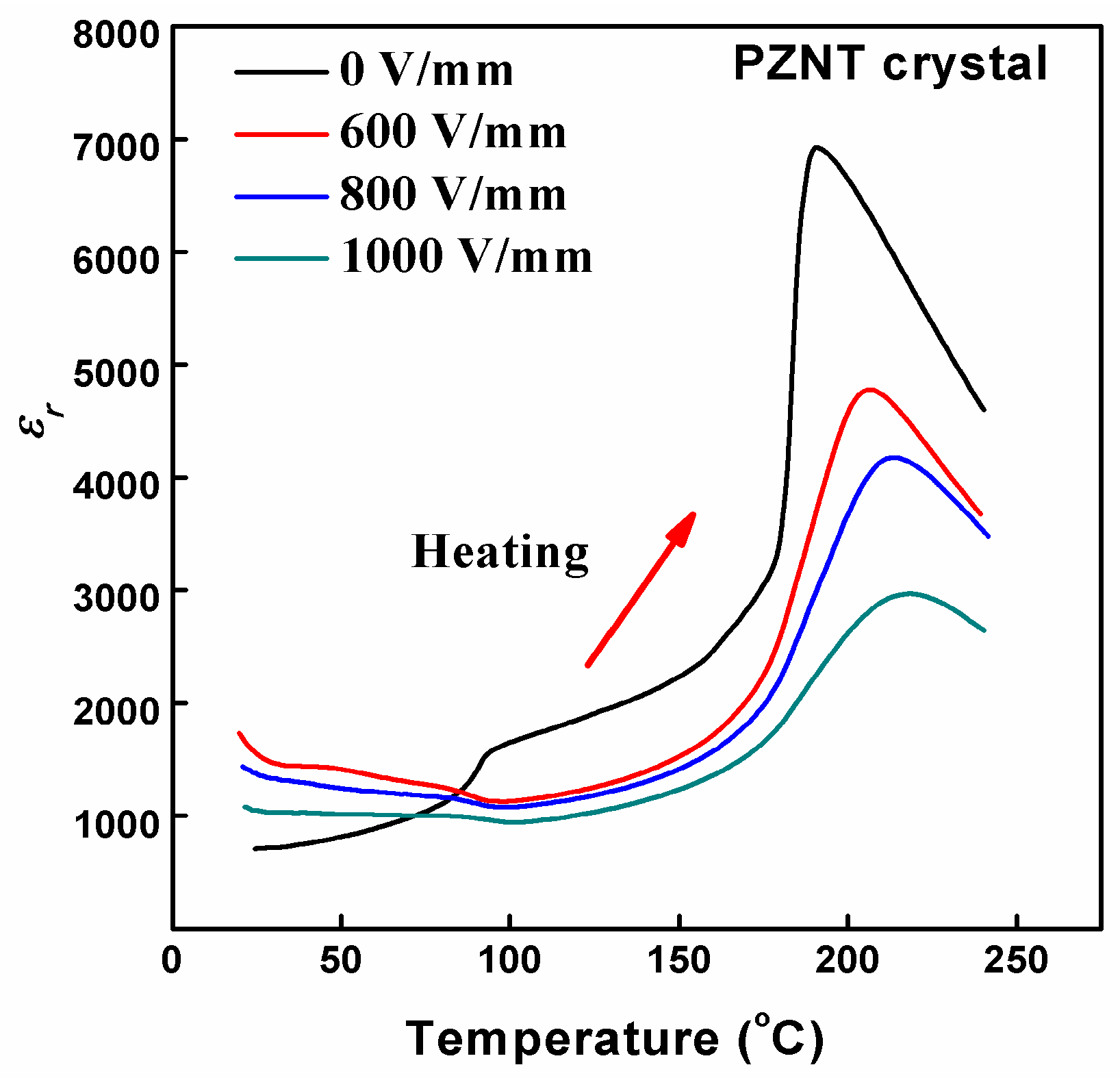
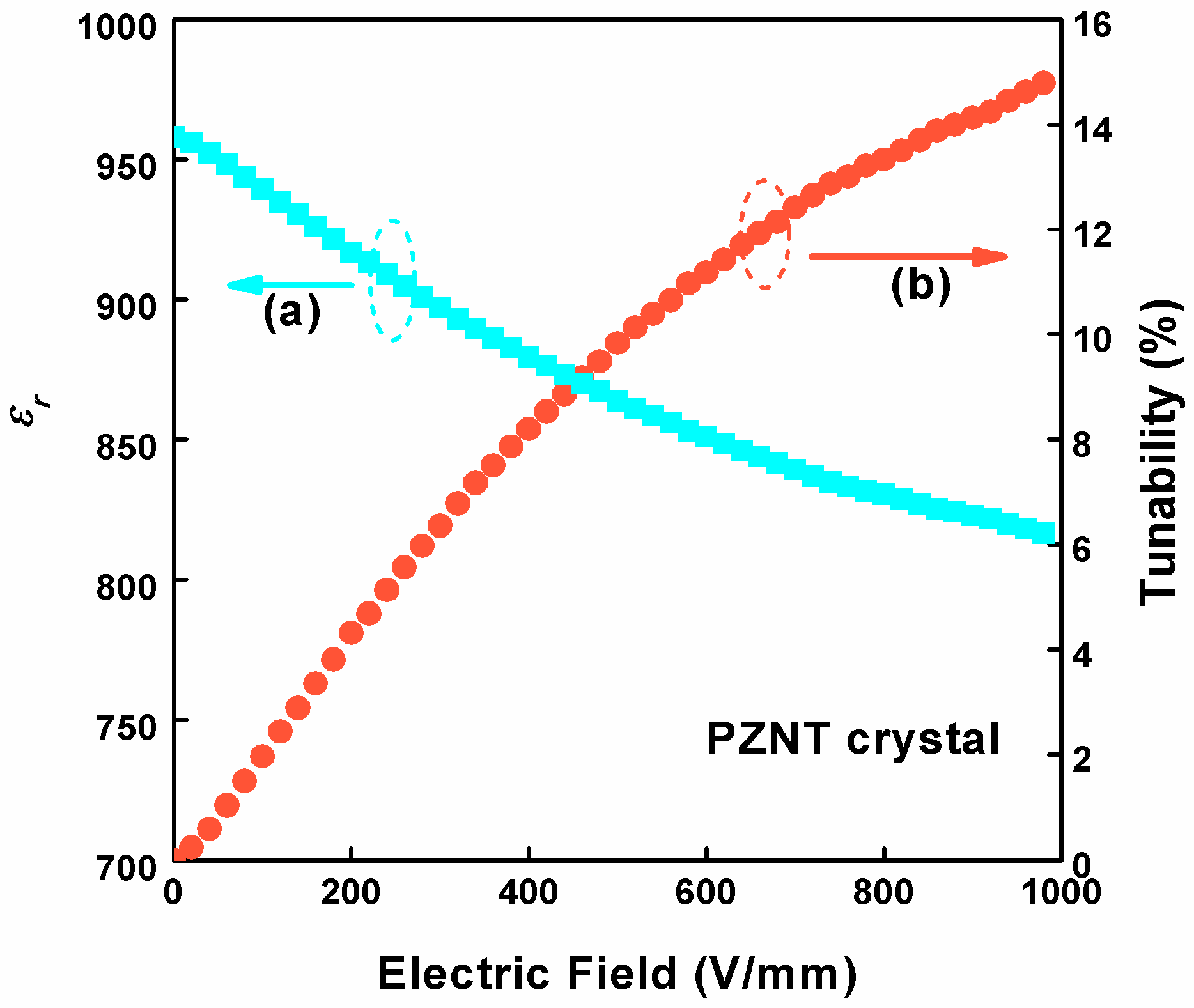

| Electric Field (V/mm) | 0 | 600 | 800 | 1000 |
|---|---|---|---|---|
| εm | 6934 | 4779 | 4179 | 2970 |
| Tm (°C) | 190 | 206 | 214 | 218 |
© 2017 by the authors. Licensee MDPI, Basel, Switzerland. This article is an open access article distributed under the terms and conditions of the Creative Commons Attribution (CC BY) license (http://creativecommons.org/licenses/by/4.0/).
Share and Cite
Zhu, Z.; Tang, X.; Jiang, Y.; Liu, Q.; Zhang, T.; Li, W. Switching Characteristics and High-Temperature Dielectric Relaxation Behaviours of Pb(Zn1/3Nb2/3)0.91Ti0.09O3 Single Crystal. Materials 2017, 10, 349. https://doi.org/10.3390/ma10040349
Zhu Z, Tang X, Jiang Y, Liu Q, Zhang T, Li W. Switching Characteristics and High-Temperature Dielectric Relaxation Behaviours of Pb(Zn1/3Nb2/3)0.91Ti0.09O3 Single Crystal. Materials. 2017; 10(4):349. https://doi.org/10.3390/ma10040349
Chicago/Turabian StyleZhu, Zhi, Xingui Tang, Yanping Jiang, Qiuxiang Liu, Tianfu Zhang, and Wenhua Li. 2017. "Switching Characteristics and High-Temperature Dielectric Relaxation Behaviours of Pb(Zn1/3Nb2/3)0.91Ti0.09O3 Single Crystal" Materials 10, no. 4: 349. https://doi.org/10.3390/ma10040349






